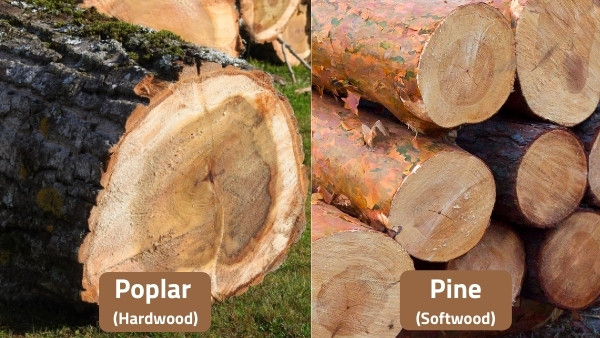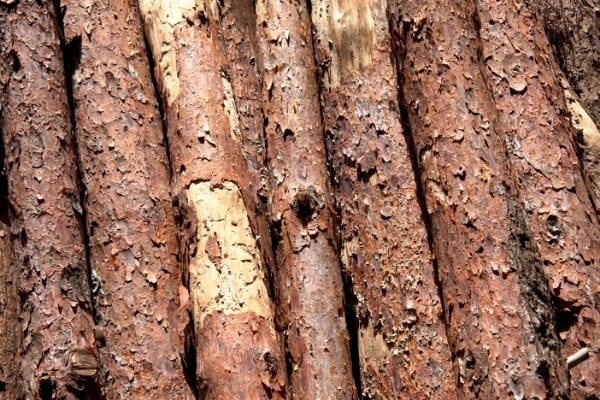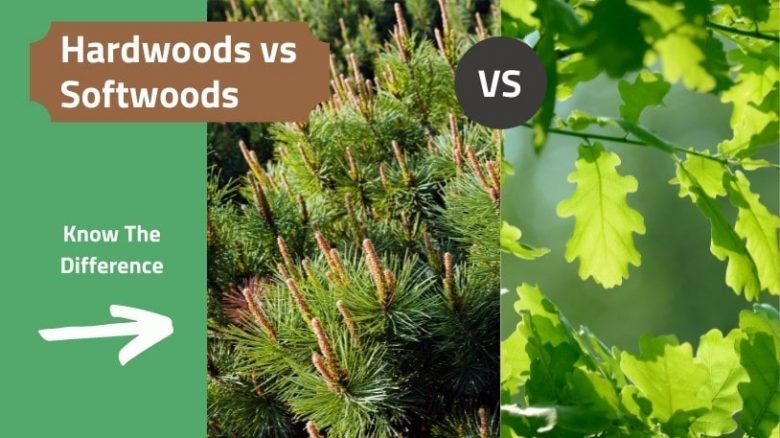There is so much misinformation on the internet about how to tell the difference between hardwood and softwood, and we felt it best to put the record straight. This article will explain how hard or soft wood feels, but it does not guarantee which category it belongs in. There are ways to tell, and we’ll discuss these. We’ll also explain how wood is rated for hardness and give you some common ratings. Finally, we’ll suggest some common hardwoods and softwoods and pointers to consider when selecting between the two.
Growing up with my woodworking father, I recall hardwoods always seemed so exotic to me, such as mahogany, walnut, or maple. He produced beautiful furniture and then French polished them to a deep, lustrous sheen. Softwoods, on the other hand, seemed quite utilitarian to me. However, as I developed my woodworking career, I realized that wood selection depends on many variables, with softwoods often a far more practical choice for a project.
Stay with us for a few minutes, and we’ll step through the hardwoods versus softwoods debate and give you the information needed for your next project.
What is the difference between hardwoods and softwoods?
It’s not about how hard the wood is!
I’ve read so many incorrect blogs on the net about this. Some say if you can dig your fingernail into it, it’s softwood, and if you can’t, it’s hardwood. Wrong. Others say you can tell by the grain density or by being able to dent or chip it with a chisel. Again, wrong.
Let me illustrate with two extreme examples. Balsa wood is classified as hardwood, yet I can dig my fingernail into balsa wood and easily chip it with a chisel. Yew is classified as a softwood, but its hardness rating, which we’ll discuss shortly, exceeds oak, hard maple, and walnut. Try digging your fingernail into yew, and it’s your fingernail that’ll give.
The terms softwood and hardwood refer to how a tree produces its seeds.
Coniferous trees produce their seeds completely exposed, such as yew or ginkgo, or in cones, such as pines or cypress. These trees are called gymnosperms, which in Latin means naked seeds. If the wood you are using comes from a gymnosperm tree, it is a softwood.
Deciduous trees, or trees that lose their leaves in temperate climates or during droughts in tropical climates, have flowers and produce their seeds enclosed within a fruit. Oak and walnut are two obvious examples of such trees. These trees are called angiosperms, which refer to seed and container in Latin. If you are using wood from an angiosperm tree, it is a hardwood.
This video takes you through what we’ve just discussed.
With all that said, wood from a gymnosperm is generally at the softer end of the hardness scale for wood, but not always, which is why these rules-of-thumb about fingernails and chisels aren’t helpful.
So how can you tell hardwood from softwood?

There are only two ways to be scientifically sure. The first is to identify the wood type, and once you know what tree it’s from, you can classify it as either angiosperm or gymnosperm.
The second method is through the use of a magnifying glass. When looked at through a powerful magnifying glass, hardwoods have visible pores used to transport nutrients and water. While softwoods have a similar cellular structure, there are two differences. Gymnosperm trees transport water around the tree with a structure called longitudinal tracheids and medullary rays. These produce sap, while no pores are visible, as you would see with hardwood.
The University of Kentucky has published a helpful document that takes you through the differences using magnifications of hardwoods and softwoods to illustrate what to look for. It’s five pages long, and if you’re interested, you can find it here.
The Janka Hardness test for wood
Gabriel Janka was an Austrian-born researcher who measured how different wood species were resistant to dents and wear. His method involved using a metal sphere of 11.28mm or 7/16″ diameter, which he forced into the wood to exactly one-half of its circumference. He measured the force required in pounds-force or Newtons.
This method allowed a relative ranking of woods for hardness, known as the Janka Hardness test. The softest wood measured is balsa wood, a hardwood with a Janka rating of 70 pounds-force, or 310 Newtons. The hardest wood measured is the Australian Buloke, a species of the ironwood family, with a Janka rating of 5,060 pounds-force, or 22,500 Newtons.
The following table gives the Janka Hardness rating of commonly used woods.
Species | Janka Hardness | Species | Janka Hardness | |
Australian Buloke | 5,060 lbf (22,500 N) | Larch | 1,200 lbf (5,300 N) | |
Lignum vitae | 4,500 lbf (20,000 N) | Teak | 1,155 lbf (5,140 N) | |
Ebony | 3,220 lbf (14,300 N) | English Oak | 1,120 lbf (5,000 N) | |
Cocobolo | 2,960 lbf (13,200 N) | Cherry | 995 lbf (4,430 N) | |
Boxwood | 2,840 lbf (12,600 N) | Red Maple | 950 lbf (4,200 N) | |
Golden Teak | 2,330 lbf (10,400 N) | Paper Birch | 910 lbf (4,000 N) | |
Merbau | 1,925 lbf (8,560 N) | Eastern Red Cedar | 900 lbf (4,000 N) | |
Jarrah | 1,910 lbf (8,500 N) | Southern Yellow Pine (Longleaf) | 870 lbf (3,900 N) | |
Tigerwood | 1,850 lbf (8,200 N) | African Mahogany | 830 lbf (3,700 N) | |
Hickory, Pecan, | 1,820 lbf (8,100 N) | Sycamore | 770 lbf (3,400 N) | |
Rosewood | 1,780 lbf (7,900 N) | Silver Maple | 700 lbf (3,100 N) | |
African Padauk | 1,725 lbf (7,670 N) | Southern Yellow Pine (Shortleaf) | 690 lbf (3,100 N) | |
Merbau | 1,712 lbf (7,620 N) | Douglas Fir | 660 lbf (2,900 N) | |
Zebrawood | 1,575 lbf (7,010 N) | Larch | 590 lbf (2,600 N) | |
Hard & Sugar Maple, | 1,450 lbf (6,400 N) | Chestnut | 540 lbf (2,400 N) | |
White Oak | 1,360 lbf (6,000 N) | Yellow Poplar, Poplar | 540 lbf (2,400 N) | |
Ash | 1,320 lbf (5,900 N) | Western White Pine | 420 lbf (1,900 N) | |
American Beech | 1,300 lbf (5,800 N) | Basswood | 410 lbf (1,800 N) | |
Red Oak (Northern) | 1,290 lbf (5,700 N) | Eastern White Pine | 380 lbf (1,700 N) | |
Yellow Birch, Iroko | 1,260 lbf (5,600 N) | Balsa | 70 lbf (310 N) | |
Heart pine | 1,225 lbf (5,450 N) |
What are the cost differences?
As a very general rule, hardwoods are more expensive than softwoods. However, many variables go into pricing timber, with rarity, geographical location, transport costs, impacts from weather, and demand all playing a part.
Speed of growth and farming intensity are critical factors. Hardwoods are generally slower growing than softwoods. A pine tree may take ten years to reach a size enabling it to be harvested for timber. For an oak to reach a size that yields the same amount of timber, you may be waiting for 80 to 100 years.
Due to the rapid growth of softwoods, many are farmed intensively to provide timber for buildings, paper, furniture, and woodchips. Therefore, millions of hectares of pine and poplar forests exist, making these woods a commodity that doesn’t command a premium price.

Specific uses for hardwoods and softwoods
There are general guidelines to follow when choosing between a hardwood and a softwood for your next project. Four characteristics important to consider are durability, hardness, density, and cost.
- Durability refers to wood’s capacity to last when exposed to dampness or pests.
- Hardness refers to its ability to withstand knocks and dents.
- Density refers to how much the wood weighs.
- Cost needs no explanation.
Some wood species are very durable and resistant to fungal decay, pests, and termites and are preferred if you wish to use wood outside. A wood classification system gives you the durability of common woods. It classifies wood into five categories, ranging from non-durable, meaning it will last less than 5 years, to very durable, lasting more than 25 years. You can download a useful chart here. If you will only ever use the item inside, a less durable wood might be fine if sealed, stained, or painted.
Hardness we’ve already discussed. You should consider your particular project and how exposed it will be to knocks and dents. If you wish to build a piece of furniture that you intend to use a lot and wish to last a long time, you should consider using wood with a good hardness rating. Furniture used frequently and made of pine will age rapidly, displaying the dings and dents from hard use.
Density might not be an issue for you if you intend to make a large dining table. Once it’s in place, it’s unlikely you’ll move it often. However, if you wish to make children’s toys, something too heavy will be cumbersome for a child to move and possibly injury-causing should it come into contact with another child’s head at speed. This calculator gives you the approximate densities of common woods to allow you to make relative comparisons.
The cost largely results from the answers to the preceding three considerations. However, if you don’t need durability and hardness, and density isn’t an issue, why pay a premium to buy a hardwood unless appearance, grain, and color are important? If you intend to paint the item, then buy cheap softwood.
List of common hardwoods and softwoods
Softwoods | |||
Janka Rating | Color | Price | |
Pine | 870 lbf | White through yellowish-brown | $ |
Cedar | 900 lbf | White to red depending on type | $+ |
Spruce | 700 lbf | Yellow white to reddish brown | $+ |
Douglas Fir | 660 lbf | Light brown with hints of yellow and red | $+ |
Hardwoods | |||
Janka Rating | Color | Price | |
Poplar | 540 lbf | White to creamy color | $+ |
Oak | 1,200 | Ranging from red to white | $$+ |
Cherry | 1,000 | Pale color aging to a rich reddish-brown | $$+ |
Walnut | 1,200 | Light to dark chocolate brown | $$$$ |
Maple | 1,400 | Ranges from cream through to gold | $$ |
Frequently Asked Questions
Is pine a hardwood or a softwood?
Pine is a softwood because it belongs to the family of gymnosperm trees which have evergreen needle-like leaves.
Is oak a hardwood?
Yes, oak is a hardwood. Oak belongs to the family of angiosperm trees. Oak is actually one of the harder hardwoods with a Janka hardness score of 1,120 LBf or higher, depending on the type.
Is cedar a hardwood or a softwood?
Cedar is a softwood. Cedar, just like pine, is a coniferous wood belonging to the gymnosperm family.
Is redwood hardwood?
No, redwood is not a hardwood. Redwood is a softwood because it is a gymnosperm, which means that it grows evergreen needles and cones just like pine or cedar.
Is Yew a hardwood?
Yew is a very hard wood. Yew has a Janka hardness score of 1,520 lbf, which is harder than oak. Despite that, yew is actually classified as softwood because it is a gymnosperm tree.
Summary
We’ve touched on a lot in this article and given you some references to learn more. However, I trust you’ve gained the information you need to consider before selecting between softwood and hardwood for your next project.

